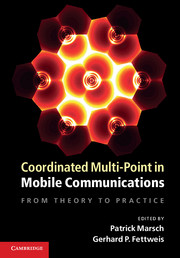Book contents
- Frontmatter
- Contents
- List of Contributors
- Acknowledgements
- List of Abbreviations
- Nomenclature and Notation
- Part I Motivation and Basics
- 1 Introduction
- 2 An Operator's Point of View
- 3 Information-Theoretic Basics
- 4 Gains and Trade-Offs of Multi-Cell Joint Signal Processing
- Part II Practical CoMP Schemes
- Part III Challenges Connected to CoMP
- Part IV Performance Assessment
- Part V Outlook and Conclusions
- References
- Index
1 - Introduction
from Part I - Motivation and Basics
Published online by Cambridge University Press: 05 August 2012
- Frontmatter
- Contents
- List of Contributors
- Acknowledgements
- List of Abbreviations
- Nomenclature and Notation
- Part I Motivation and Basics
- 1 Introduction
- 2 An Operator's Point of View
- 3 Information-Theoretic Basics
- 4 Gains and Trade-Offs of Multi-Cell Joint Signal Processing
- Part II Practical CoMP Schemes
- Part III Challenges Connected to CoMP
- Part IV Performance Assessment
- Part V Outlook and Conclusions
- References
- Index
Summary
Motivation
Mobile communication has gained significant importance in today's society. As of 2010, the number of mobile phone subscribers has surpassed 5 billion [ABI10], and the global annual mobile revenue is soon expected to top $1 trillion [Inf10]. While these numbers appear promising for mobile operators at first sight, the major game-changer that has come up recently is the fact that the market is more and more driven by the demand for mobile data traffic [Cis10]. This is simply because Moore's law in semiconductors leads to continuously more powerful mobile devices with larger storage capacity, which in the era of Web 2.0 require regular synchronization with the Internet. Consequently, Moore's law can also be found in the increase of data rates in wireless communications, as illustrated in Fig. 1.1. The main challenge, however, is that mobile users tend to expect the fast and cheap Internet access that they are used from their fixed lines (e.g. ADSL), but anytime and anywhere while being on the move. This puts mobile operators under the pressure to respond to the increasing traffic demand and provide a more homogeneous quality of experience (QoE) over the area (often referred to as improved fairness), while continuously decreasing cost per bit - and addressing the more and more crucial issue of energy efficiency [FMBF10].
- Type
- Chapter
- Information
- Coordinated Multi-Point in Mobile CommunicationsFrom Theory to Practice, pp. 3 - 6Publisher: Cambridge University PressPrint publication year: 2011



